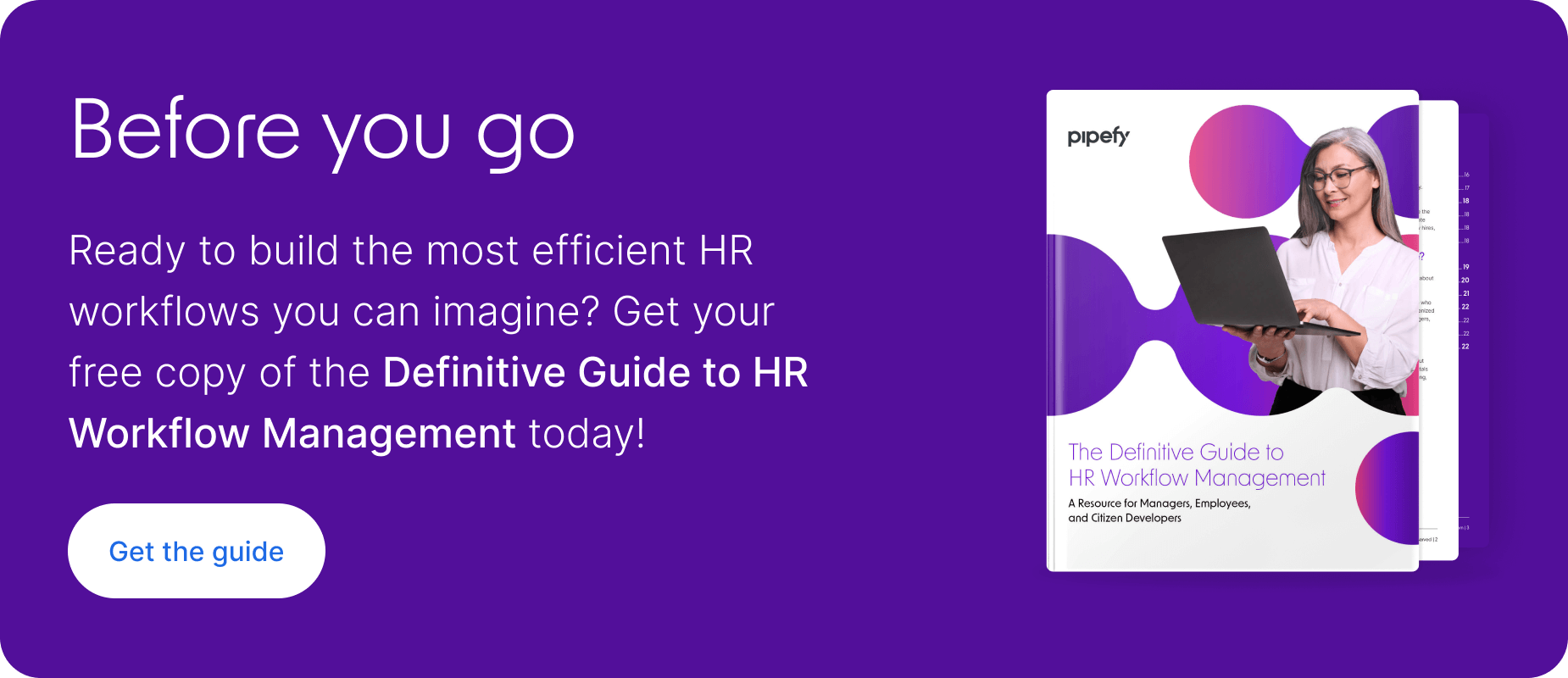
The onboarding process is a crucial point in a new hire’s journey. Data shows that new employees who have a positive onboarding experience are 69% more likely to stay with a company for three years, and 58% more likely to remain after three years if they experience a structured onboarding process. A positive and structured employee onboarding process can also lead to benefits like greater new-hire productivity.
In this thorough guide, we’ll walk through the components of an effective onboarding process, actionable steps you can take to improve the experience for new hires at your company, and answer frequently asked questions.
Definitive Guide to HR Workflow ManagementDownload now
What is employee onboarding?
Employee onboarding is the HR process of integrating new employees into your organization over a period of weeks or months. It includes all the tasks and activities necessary to prepare new hires to succeed as productive members of the team.
For some companies, employee onboarding is little more than an exercise in paperwork. New hires complete forms and then report to their manager for assignments.
While this approach to onboarding may help your HR team enter new hires into the CRM system, it doesn’t do much to help them acclimate to the company culture or ensure that they have all the tools and information they need to succeed. More importantly, it fails to help build the relationships a new employee needs in order to fully integrate into the team.
Onboarding vs. orientation
Keep in mind that onboarding is not the same as orientation. Orientation is just one step in the onboarding process that introduces new employees to the workplace, whereas onboarding is a series of steps that happens before, during, and after orientation.
What is the employee onboarding process?
Employee onboarding is a structured process composed of a series of tasks and workflows spanning various teams and departments, such as IT, accounting, and HR. Each task or workflow in the process achieves one element of the onboarding process.
For example, a typical onboarding process includes payroll setup, benefits enrollment, issuing equipment, and providing access to systems and apps. These activities require input or action from the finance, People Ops, and IT teams, among others.
Now let’s look more closely at how a successful onboarding process unfolds.

Looking at employee onboarding as a multi-step process, rather than a single step or a checklist, is the first step in building better onboarding experiences for new hires joining your organization.
The employee onboarding process begins when you make an offer to a candidate and extends through the employee’s first several months (or even first year) of employment, depending on the organization and complexity of the role.
Between these two points in the extended process, it’s important to plan for how you will:
- Communicate with candidates about who you are and explain how employees can best excel within your organization.
- Prepare employees prior to their first day.
- Introduce new employees to their colleagues and workplace on the first day.
- Support them as they begin to settle into their new roles and face the challenges that come with them.
Also read The Official Handbook to Employee Management
Benefits of improving your employee onboarding process
Improving your employee onboarding process not only makes for better new-hire experiences, it also leads to larger business benefits, including lower turnover rates, enhanced employer branding, improved employee satisfaction, and enhanced productivity.
Lower turnover rates
Studies show that onboarding experiences have a direct impact on employee retention. A negative onboarding experience can result in the loss of an employee.
Improving the process by which you integrate employees into your organization and introduce them to their colleagues and workplace can empower them to be successful long-term and improve their chances of staying with your organization.
Improved employer branding
How employees view your company is just as important as the benefits or perks offered. That’s why your employer brand matters — from your website to your presence on job boards to the experience candidates have when they apply, interview, or are hired.
A manual or unstandardized process can result in:
- Negative candidate experiences
- Delayed responses from employers
- A complicated application process
- An unpleasant interview process
- Poor collaboration between teams to finalize offers and start dates
When gone unchecked, the negative results of manual onboarding processes can snowball into a reflection of your company — and no one wants to stay at a company that offers negative experiences.
Higher employee satisfaction
Starting a new job is an exciting time for an employee. That is until they realize they don’t know where to go, what time to arrive, when or how they’ll get paid, or what their first day of work will look like.
This is why onboarding should begin long before an employee’s start date. A misstep in the pre-onboarding phase can lead to anxiety, dissatisfaction, and even serious financial consequences for an employee who didn’t know that they’d have a gap in benefits, for example.
Setting the tone of their employment as supportive, clear, and organized before they even start can improve employee retention and overall employee satisfaction.
Enhanced productivity
The Society for Human Resource Management reports that companies with a standard onboarding process experience 50% greater new-hire productivity.
That’s why building an onboarding process that emphasizes training and educating new employees on role expectations, tools, and resources is an important aspect of employee performance and job satisfaction.
Better experiences for HR teams
If your onboarding process still relies on manual and repetitive tasks like data entry, document collection, or sending out various versions of the same email, the biggest improvement that can be made that benefits both HR teams and employees is automation.
Not only does process automation eliminate time-consuming work for your HR teams, it also makes for a more reliable and error-free process. Plus, with the benefit of automated notifications and emails, it ensures that companies establish a good working relationship with new hires from the start.
Employee onboarding process steps
Step 1: Release the offer for candidate review
Extend a job offer to the candidate that expresses your gratitude for their interest in sharing their talents with your organization. Reiterate mission, vision, and core values and clearly communicate why you chose them for the role despite a competitive candidate pool.
Offers should also include key details like estimated start date, benefits and salary, and any other relevant information that the candidate may need to review before accepting the offer.
Step 2: Offer acceptance
Once the candidate has reviewed and agreed to the terms presented or negotiated, you’ll receive formal acceptance via a signed contract or offer. Allow the candidate to give ample notice to their current employer and work to honor any previously approved commitments or time off.
With the offer accepted, the pre-onboarding will soon begin.
Step 3: Gather remaining information and set up equipment
While waiting for the new employee to start, complete any steps needed to prepare them for their first day. Schedule background screens, run reference checks, or request any documentation, records, or transcripts that you may need to get the paperwork you need completed.
During this time, connect with IT so that employees have the equipment, licenses, or accounts — like email or messaging platforms — ready to use on day one. You may also need to reach out to the new hire for information like equipment preference and home address.
This is especially important for employees that work remotely since their first day will be spent away from a traditional office location and won’t have the benefit of turning to a coworker for advice.
You can also share a pre-onboarding agenda with the new hire listing everything they can expect and should be aware of, such as what time to arrive or start working, where to park, who to report to, what their first day/first week will look like, and whatever else they may need to know.
Note that many of these administrative tasks, like collecting signed documents and notifying departments that play a role in the onboarding process, can be easily automated with a digital process automation software.
Step 4: Prepare colleagues for the new employee
The manager will know about the new employee before the rest of the team, so encourage managers to let the team know about their new coworker. Introduce the new employee to the rest of the team and provide clarity around their role and responsibilities, and answer any questions they may have.
Step 5: The first day (welcoming the new employee)
The day has finally come, so welcome the new employee and introduce them to their new team. This day is also when the official onboarding process begins. Schedule introductory team meetings, manager check-ins, and any orientation-related meetings to acclimate employees to their new job and company culture.
Complete any obligatory paperwork, ensure a tour of the office has been provided (if working hybrid or at an office), and verify that their equipment is working and connected. Additional tasks for their first day may also include:
- Resolving any equipment issues
- Setting up payroll and benefits
- Reviewing the onboarding schedule for their first week
Step 6: The first week (training, orientation, and technical onboarding)
Onboarding usually occurs during the first week. The purpose is to train employees on internal processes and procedures, orient them, share resources, introduce them to leaders, and reiterate how their work will ladder up to the company’s core values and mission.
During this time, employees will also be trained on any technical knowledge they will need to successfully complete their job.
Step 7: The first months (monitoring and following-up)
Once the new employee has adjusted to their new role, monitor their performance and check-in with them during the first three or six months to learn how their experience has been so far and whether the onboarding process has been successful.
Ask if they have the tools and resources they need, if they feel welcome, if they know who to go to with questions, and how HR teams and their manager can best support them in their role. Because
Step 8: The first year (annual ‘renewal’ check)
Employee retention hinges on how well they were onboarded. At the one-year mark, conduct another check-in to see how their time has been, whether their perception of the company has changed since they started, areas in which they are struggling in, and any other relevant information that may inform whether they are at risk of leaving the company.
FAQ about employee onboarding process flow
When does onboarding start?
Onboarding starts when an offer is extended to a candidate and it is accepted. It’s important to note that whether a candidate accepts or rejects an offer is influenced by their impression of your organization based on external research and their overall interview process experience.
How long does it last?
Onboarding can last anywhere from three to 12 months, depending on the complexity of the role, the size of the organization, and the structure of a company’s onboarding process.
What do new employees need to know about the culture and work environment?
Culture and work environment are important considerations for job seekers today. Questions about culture and work environment will commonly come up during the interview process.
This is a candidate’s opportunity to learn how a company operates, gauge employee satisfaction, whether the company’s core values align with theirs, and potential to grow opportunities within the company. It’s also a company’s chance to answer questions and explain employee benefits and core values.
Once hired, reiterate to new employees your company’s mission, vision, and core values, in addition to your company policies, benefits, and code of conduct.
What role does HR play in the process?
HR and People Ops teams should design, implement, and facilitate the process, but hiring managers play the most important role in successful employee onboarding as they will be the new hire’s day-to-day contact.
What kinds of goals can HR set for new employees?
HR should encourage new employees to actively participate and engage in the onboarding process by connecting with collaborating departments and introducing themselves to colleagues.
How can HR gather feedback on the program and measure success?
Whether it’s through automated employee surveys or one-on-one check-ins, it’s critical that HR teams follow-up with new hires to find out what they loved about their onboarding and what could have gone better.
Create better experiences with an automated employee onboarding process
Employee onboarding is one of the most important processes in your organization. When managed effectively, employee onboarding ensures that your company is preparing new hires for success and investing in the future by retaining the right people.
Low-code automation helps HR teams easily build an onboarding process that helps new hires acclimate to the team and feel confident about their roles. Low-code automation uses a visual user interface that lets HR teams make the most of their existing apps and systems by achieving stack extensibility to create unified employee experiences.






